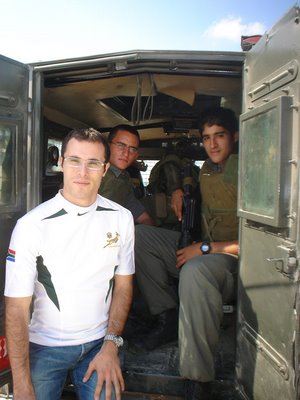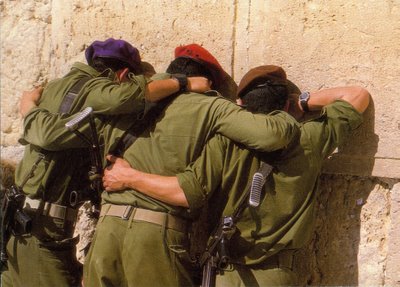
Questo è quello che ha scritto la mia cara amica Hava:
Nell'ultima guerra del Libano piu' che nelle precedenti abbiamo tenuto contatto con i nostri ragazzi per mezzo cellulare che quasi tutti hanno con se, ma passato il confine non funziona e per intere giornate mancano le notizie. E se pure si riesce a comunicare non si sa mai che cosa potra' succedere fra un momento.
I padri, generalmente soldati e ufficiali di riserva, riescono ad interpretare ogni briciola di notizia trasmessa dalla tv. o dall'internet che ne fanno accenni.
In seguito alla fratellanza dei combattenti si sviluppa uno stretto legame fra le famiglie che si sostengono a vicenda, fanno turni per contattare il comando dopo ogni battaglia. Se le notizie riferiscono di feriti c'e' da immaginare l'ansia di saperne di piu'. Ma l'ansia non ci abbandona un istante, non ci lascia dormire quando un membro nostro e' in pericolo.
I ragazzi da parte loro evitano di parlarne a casa, per non inquietare le famiglie, ma sopratutto perche' nei pochi momenti di tregua vogliono scordare e vogliono divertirsi. Nei momenti di tregua tornano ad essere i giovani spensierati come tutti i ragazzi del mondo. E dopo 3 anni di servizio militare molti se ne vanno "a prender aria" in paesi lontani, prima ancora di progettare il futuro.
Le famiglie dei nostri combattenti passano un inferno, che nonostante la grande solidarieta' del nostro popolo, e' anzitutto privato.

 During the War of Independence, the Syrian army reached the gates of Degania Alef, but was bravely repulsed. A burnt Syrian tank remains on the site as a memorial. The two Deganias have a combined population of nearly 1,000. Due to the hot climate and abundance of water, both Deganias are engaged in fully irrigated farming. Degania Bet has also a metal factory
and Kadish Luz were members of Degania Bet. A.D. Gordon, Arthur Ruppin, Otto Warburg and other founders of the labor settlement movement are buried on Degania Alef.
During the War of Independence, the Syrian army reached the gates of Degania Alef, but was bravely repulsed. A burnt Syrian tank remains on the site as a memorial. The two Deganias have a combined population of nearly 1,000. Due to the hot climate and abundance of water, both Deganias are engaged in fully irrigated farming. Degania Bet has also a metal factory
and Kadish Luz were members of Degania Bet. A.D. Gordon, Arthur Ruppin, Otto Warburg and other founders of the labor settlement movement are buried on Degania Alef.
Nessun commento:
Posta un commento